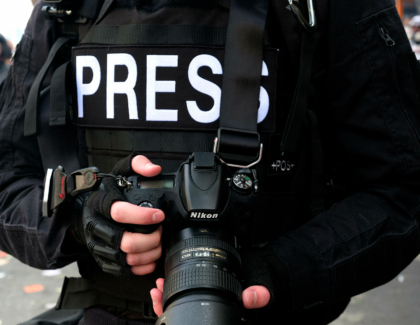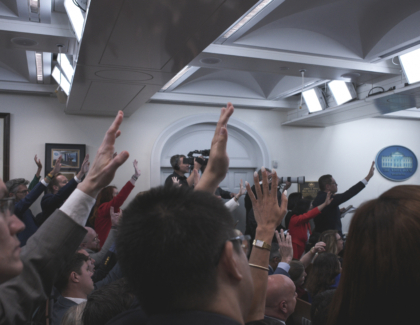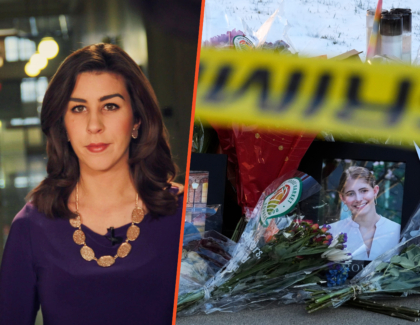Sign up for the daily CJR newsletter.
On September 5, 1972, armed men affiliated with the Palestinian militant group Black September took members of Israel’s Olympic team hostage in an apartment complex at the Olympic Village in Munich. Roone Arledge, the president of ABC Sports at the time, was adamant that the network’s sports team on the ground handle coverage instead of its news division taking over remotely from the US—and so, suddenly, they were thrown into the thick of reporting live on an unfolding crisis. The team ingeniously moved a massive studio camera outdoors to film shots of the apartment complex, dealt with miffed German police officials storming into their studio, and had to negotiate with a competing network for access to “The Bird,” a satellite that would help beam their broadcast to the world. In the end, ABC, Arledge, and the broadcaster Jim McKay would receive twenty-nine Emmy Awards for their coverage of that Olympics.
More than five decades later, a feature film by director Tim Fehlbaum goes behind the scenes of their marathon broadcast, unpacking the ethical dilemmas and myriad challenges faced by the team as they relayed the news from Munich, and using their (literal) lens as a way to tell the story of the hostage crisis itself. (In the end, seventeen people were killed, including eleven members of Israel’s Olympic delegation and five of the hostage-takers.)
September 5 follows a cast of news producers, technicians, and reporters (and Arledge, played by Peter Sarsgaard) as they improvise to get as close as they can to a rapidly developing story. The movie, set for wide release later this month, has already received numerous awards as well as a nomination for Best Motion Picture in the drama category at the Golden Globes. Before Christmas, I caught up with Fehlbaum to talk about the journalistic dilemmas at the heart of his film, why he chose to tell the story of a hostage crisis from the perspective of a newsroom, and his decision to include certain segments of the original broadcast in the film—just as they were aired in 1972. Our conversation has been edited for length and clarity.
MB: What made you want to approach this topic as a journalism movie, told through the lens of a newsroom that covered the events of Munich 1972? Would you even refer to it as a “journalism movie”?
TF: I would 100 percent refer to it as a journalism movie—maybe a journalistic thriller, almost. But also, in a way, it’s a chamber play. The reason we chose that angle is because of what an important role the media played on that day and what a turning point it was in media history. We spoke with Geoffrey Mason, a character played by John Magaro, and he told us about his experience. He was twenty years old, a rookie back then working for ABC, and during this marathon of broadcasting, he was there. Listening to his story and about the challenges they faced—like how, suddenly, the police came into the studio and told them to turn off the camera—those are the things that made us confident that we should tell the story entirely from that angle.
What, to your mind, were the interesting journalistic dilemmas that the ABC Sports team faced that day that you wanted to represent on-screen?
The interesting thing is that these were people who a few hours earlier were reporting on a swim race, on a sports event, but they were not experienced or trained in reporting on a crisis. In the morning, they had this idea of Why don’t we just do the coverage in the studio with one camera and push out the other one, put it on a hill that was really close to the apartment and show everything that’s happening? But shortly before they go live—and we show this in the movie—they suddenly realized, Hold on, but they threatened to kill people. We have a live camera that is sending [footage] as we speak. What do we do if this actually happens? Do we show it? Do we turn off the cameras or not? That is one of the most interesting decisions and challenges that they get confronted with in the movie.
I’m from India, and thirty-six years after the Munich Olympics, there was a terror attack in Mumbai. There were television crews outside a hotel which had been taken hostage by terrorists. And they were broadcasting live footage of the response by the security personnel. Later, media reports said that it was likely that the terrorists were staying abreast of the footage that was being broadcast from outside the hotel. So it was very interesting to see that journalistic dilemma of presenting live information.
Yeah, and also a reminder that back in the day, that was new. Perhaps they suddenly realized that not only were a lot of people around the world watching this, maybe it’s also being watched in that very apartment. Where is the line between spectacle and news? When making a movie, you get confronted with some of the same questions that these characters were confronted with. Today, we are surrounded by such a rapidly growing media landscape. Everything is coming at us faster and at the same time, and we consume news all the time. I thought, especially in today’s world, that it’s interesting to take a step back and see how a little more than fifty years ago, this was the first time that an event like this was on TV.
You made an interesting filmmaking choice by keeping the actual anchor segments from the original broadcast as part of the movie. Why did you decide to do that?
We did re-create some of the footage; we shot some of the things in the Olympic Village, which by the way still looks pretty much the same. Out of respect, we did not want to show [actual footage of] anyone who lost their life in the movie. We always had to make decisions on where we stay true to the original material and where we re-create something. But I knew early on that we could never re-create the performance of the host, Jim McKay. He has his very unique way of reporting into the camera that’s also very specific for that time—he constantly tries to stay professional, but then you see his emotions coming through. And he also is not like a showman, right? He doesn’t make this about himself. It is a very touching performance, and this would have been hard to re-create with an actor. I even said that if we don’t get McKay, then I don’t want to do the film at all, because he’s also the face of that broadcast. The idea was that we have our scenes mixed with these original scenes and that our cast could actually interact with the real Jim McKay on the monitor. I actually think that on the poster, there should be a picture of Jim McKay. He is, to me, a key part of the ensemble.
You captured a lot of the fascinating media lingo from the time in your film, like the satellite being referred to as “The Bird.”
I’m glad you noticed it. I was a little bit proud of that word: “The Bird.” Again, this is something that you don’t come up with as a writer; this is something that we heard from the real Geoffrey Mason. We gave him every other draft to read, and then we asked him, “Is the language they use correct?” And he said, “You know, we always referred to the satellite as ‘The Bird.’” That makes so much sense, because there were not so many satellites in orbit yet; it was The Bird where you could book that slot [for your broadcast]. During my research, I spent a lot of time in sports control rooms, observing these people. It’s these little details you find that hopefully make a difference to whether a portrayal of a work environment is accurate or not.
Toward the end of the film, there’s a scene that shows some rumor-mongering or misinformation claiming that the hostages had been rescued. From 1972 to the present day, there’s that common thread of misinformation, whose presence has only been magnified ever since…
Yeah, I talked to people who work in today’s newsrooms and saw the film, and they told me that these are the same questions they are discussing every day. Even though technology has changed, questions on how many sources do we need, et cetera, [have stayed the same]. Back then, it was complex. Today, too, it is complex.
The content of the movie is related to the Israel-Palestine conflict. And the movie is releasing in the midst of a massive recurrence of hostilities between Israel and Palestine. Has that played on your mind as the release gets closer—whether people would interpret the film in certain ways that you might not anticipate or want?
Of course this is on my mind, ever since this conflict so tragically escalated again. What happens in the world today will have an influence on how people see films. This film, though, is about that very specific moment in time and from a very specific perspective, and we hopefully make the audience engage with questions about our media environment, through that historical lens. We had finished editing the film before the tragic events that made the conflict escalate again.
Everyone’s going to take away something different from the film, but what would you want viewers to take away from it?
Maybe that, after watching the film, you start to discuss how we consume media today, and you start to reflect on the complexity—but also the importance—of crisis reporting.
Other notable stories:
- Yesterday, multiple fires, whipped by strong winds, began to devastate areas around Los Angeles, forcing tens of thousands of people to evacuate their homes; more wind is forecast for today, and so the end is not yet in sight. As apocalyptic images began to circulate, journalists in fire-retardant suits rushed to the scene to report, though the wind made it difficult for them to stand upright, let alone for news helicopters to be able to capture aerial shots. As residents fled the star-studded Pacific Palisades area—in some cases abandoning cars to progress on foot—local news outlets interviewed them; Eugene Levy, the actor and honorary mayor of the area, told the LA Times that he “couldn’t see any flames but the smoke was very dark.” That paper has dropped the paywall around its ongoing live coverage of the fires, which you can find here.
- Also yesterday, Donald Trump held a news conference for only the second time since winning reelection in November; the ostensible purpose was to announce foreign investment, but the more salient takeaways ended up being about windmills, whales, and Trump’s refusal to rule out using military or economic means to coerce Panama into giving up its eponymous canal and Denmark into ceding Greenland. (Trump’s son Don Jr. visited Greenland yesterday, though apparently he was only there for tourism and to record a podcast.) Meanwhile, the Washington Post’s Jeremy Barr canvassed ten industry leaders on how the media should cover Trump’s second term. Jill Abramson, the former Times editor, recommended assigning a reporter to monitor right-wing media.
- As the media reporter Oliver Darcy previewed over the weekend, the Post started making layoffs on its business side yesterday, with roughly a hundred staffers said to be affected; the majority of the cuts came in the Post’s advertising department and the public relations team was also hit hard, with the paper’s head of communications suggesting that it will end the “dedicated practice” of promoting its journalism “across broadcast and traditional media outlets” and instead institute a “Star Talent Unit” focused on “personalities and creators.” Meanwhile, HuffPost also announced cuts, telling employees that it expects to eliminate more than thirty editorial positions.
- Late last year, the government of Israel announced that it would boycott Haaretz, a liberal newspaper, including by starving it of state-allocated advertising funds; the immediate pretext for the boycott was a remark that the paper’s publisher made referring to “Palestinian freedom fighters,” but as Aluf Benn, the editor in chief of Haaretz, wrote for CJR, Benjamin Netanyahu, the right-wing prime minister, has long sought to weaken the paper. Now Haaretz is appealing against the advertising boycott, describing it as “unreasonable” and “fundamentally illegal,” and seeking an urgent court hearing.
- And the music megastar Bad Bunny, who has a new album out, appeared on a morning news show in his native Puerto Rico yesterday—as an anchor. Dressed “like a freshly graduated broadcast journalism major,” he “reported current events straight to camera without breaking character, stacked his little papers on the news desk, made an attempt at explaining the weather, and took a shot of Pitorro de Coco (also the name of a song off the album) with the rest of the anchor team,” The Cut’s Emily Leibert writes. Bad Bunny isn’t the first artist to have fun with the codes of the TV newscast: the Rwandan Belgian rapper Stromae has done likewise in France, as we wrote in 2022.
Has America ever needed a media defender more than now? Help us by joining CJR today.







